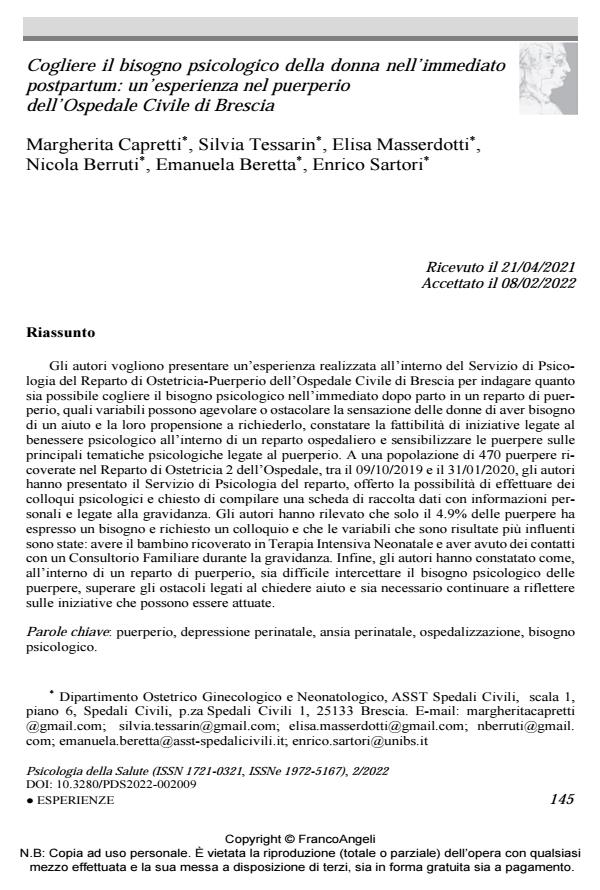Detecting the psychological need of the woman in the immediate postpartum: an experience in the puerperium of the Ospedale Civile in Brescia
Journal title PSICOLOGIA DELLA SALUTE
Author/s Margherita Capretti, Silvia Tessarin, Elisa Masserdotti, Nicola Berruti, Emanuela Beretta, Enrico Sartori
Publishing Year 2022 Issue 2022/2
Language Italian Pages 16 P. 145-160 File size 260 KB
DOI 10.3280/PDS2022-002009
DOI is like a bar code for intellectual property: to have more infomation
click here
Below, you can see the article first page
If you want to buy this article in PDF format, you can do it, following the instructions to buy download credits

FrancoAngeli is member of Publishers International Linking Association, Inc (PILA), a not-for-profit association which run the CrossRef service enabling links to and from online scholarly content.
The authors want to present an experience carried out in the Psychological Service of the Obstetric-Puerperium Unit of the Ospedale Civile in Brescia, to evaluate the feasibility of detecting the psychological need in the immediate postpartum in a puerperium unit, assessing which variables might facilitate or hamper the new mothers need and their propensity to ask for help, investigate the feasibility of new initiatives related to the psychological need inside an hospital unit and sensitize the new mothers on the main psychological issues related to the puerperium period. To a population of 470 new mothers hospitalized in the Obstetric Unit 2 of the Hospital, from the 9th of October 2019 to the 31st of January 2020, the authors presented the Unit’s Psychological Service, offered the possibility of requesting psychological interviews and asked to compile a form with personal and pregnancy related informations. The authors observed that only 4.9% of new mothers have expressed the need and requested an interview and that the most influent variables were: having their child hospitalized in Neonatal Intensive Care Unit and having already had contacts with a Family Counseling Center during pregnancy. Lastly, the authors assessed that in a puerperium unit it’s hard to intercept the psychological need of new mothers, overcome the difficulties related to seeking help and that it’s necessary to continue to investigate on new initiatives that can be implemented.
Keywords: puerperium, perinatal depression, perinatal anxiety, hospitalization, psychological need.
Margherita Capretti, Silvia Tessarin, Elisa Masserdotti, Nicola Berruti, Emanuela Beretta, Enrico Sartori, Cogliere il bisogno psicologico della donna nell’immediato postpartum: un’esperienza nel puerperio dell’Ospedale Civile di Brescia in "PSICOLOGIA DELLA SALUTE" 2/2022, pp 145-160, DOI: 10.3280/PDS2022-002009